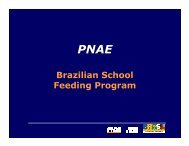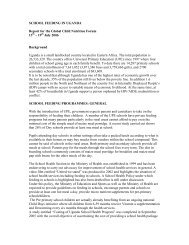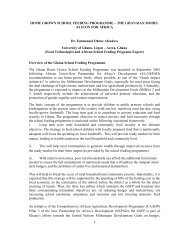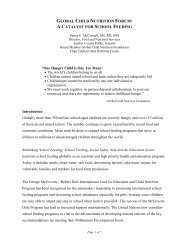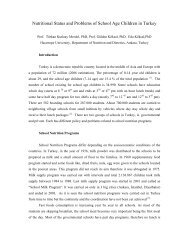EXECUTIVE SUMMARY - Global Child Nutrition Foundation
EXECUTIVE SUMMARY - Global Child Nutrition Foundation
EXECUTIVE SUMMARY - Global Child Nutrition Foundation
Create successful ePaper yourself
Turn your PDF publications into a flip-book with our unique Google optimized e-Paper software.
Scaling Up Sustainability: Linking School Feeding with Agriculture<br />
Development to Maximize Food Security<br />
May 3-7, 2011<br />
Nairobi, Kenya<br />
Country Perspectives: Design<br />
■ Speakers: Ambassador Chris Goldthwait, Consultant, American Peanut Council<br />
Representatives from Nigeria, Liberia, Zambia, Chad, Sierra Leone, and Mozambique<br />
Overview<br />
Each country has unique priorities for its school feeding program,<br />
which can be achieved through deliberate design decisions.<br />
Program design has a direct influence on the community and the<br />
financial impact of school feeding initiatives.<br />
Cultural change can also be effected through school feeding<br />
programs. Take-home rations, for instance, may motivate families<br />
to send girls to school. Designing programs in a consolidated way<br />
can deliver school feeding services in a more efficient manner.<br />
Context<br />
Representatives from Nigeria, Liberia, Zambia, Chad, Sierra Leone,<br />
and Mozambique briefly described the design of their school<br />
feeding programs. Chairperson Chris Goldthwait summarized<br />
the key messages that emerged from discussions.<br />
Key Points<br />
Program design can be used to drive specific school<br />
feeding objectives.<br />
Delegates from Nigeria, Liberia, Zambia, Chad, Sierra Leone,<br />
and Mozambique emphasized that program design is an important<br />
factor in achieving a country’s school feeding program goals.<br />
Examples of design decisions include: Nigeria has hired cooks<br />
from the private sector. Zambia improved school feeding<br />
efficiency by creating a consolidated program. Chad uses takehome<br />
rations to promote education for girls. And as Sierra Leone<br />
finalizes its program design, it intends to make locally grown<br />
foods an important part of its school feeding initiative.<br />
Nigeria<br />
Nigeria’s design includes private sector hiring.<br />
Nigeria has brought the private sector into the school feeding<br />
program by establishing a design that entails hiring and training<br />
cooks. The government sets standards that staff must adhere to.<br />
Food quality is regulated by a quality team. To strengthen the<br />
connection between farmers and the school feeding program,<br />
cooks are advised to use locally grown foods like sweet potatoes.<br />
Liberia<br />
Liberia’s food basket is designed to improve education.<br />
In Liberia, the school feeding program strives to improve<br />
education for all genders by providing nutritional meals. The food<br />
basket has been designed to meet those goals.<br />
Zambia<br />
School feeding has been consolidated to improve efficiency.<br />
Zambia has utilized school feeding programs since 2003. Since<br />
multiple programs have been used, a cost analysis was done in<br />
© 2011 GCNF and PCD. All rights reserved. Page 29<br />
2009 to evaluate which were providing the best value. This<br />
analysis found that the Ministry of Education’s program was more<br />
expensive than the others. As a result, two programs were<br />
consolidated into one with centralized management.<br />
Chad<br />
Chad encourages education for girls through take-home<br />
rations.<br />
The design of Chad’s school feeding program involves providing<br />
both in-school meals and take-home rations at 1,200 schools.<br />
Meals and rations are given to both children and adult learners.<br />
Take-home rations encourage girls to enroll in school. This has<br />
changed the traditional culture where girls stay home and only<br />
boys attend school. Since resources are limited, the program<br />
focuses on the country’s most vulnerable areas. Challenges that<br />
must be overcome include logistics issues and better reporting.<br />
Sierra Leone<br />
The school feeding program design incorporates locally<br />
grown foods.<br />
In Sierra Leone, the WFP is working with the government to<br />
evaluate the country’s school feeding programs. As the program<br />
design is formalized, significant opportunities exist for linking<br />
procurement with local farmers.<br />
Small-scale agriculture is a good food source for the school<br />
feeding program. Purchasing locally blended foods helps support<br />
local communities. Through partnerships with agricultural<br />
stakeholders, school menus have been adapted to use seasonally<br />
available and cost-efficient foods.<br />
Despite these aspirations, there are numerous challenges. The<br />
nutritional content of local foods must be guaranteed, as well as<br />
food safety and quality. In drought-stricken areas, the lack of<br />
water is an obstacle to meal preparation and hygiene. Supply<br />
and demand also are concerns. Local farmers must increase<br />
productivity to meet the demand generated from school feeding<br />
programs. From an administrative perspective, programs must do<br />
a better job balancing objectives, monitoring and evaluating<br />
performance, and accounting.<br />
Since its school feeding program design is still under<br />
development, Sierra Leone would like to explore new<br />
opportunities related to commodity exchanges, community<br />
engagement, stakeholder incentives, and technology adoption.<br />
Mozambique<br />
Mozambique has found that local procurement requires<br />
support from all stakeholders.<br />
Mozambique has had a school feeding program since 1977. Its<br />
procurement works best when all partners are involved.<br />
Mozambique’s line ministries work together with other partners to<br />
support the program. In addition to purchasing food from local<br />
farmers, students are also taught how to farm.



